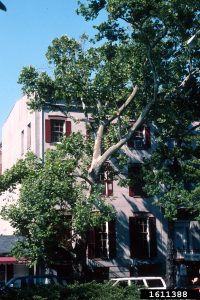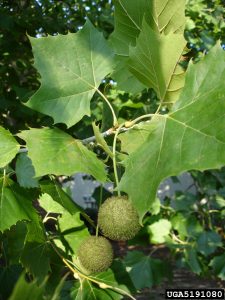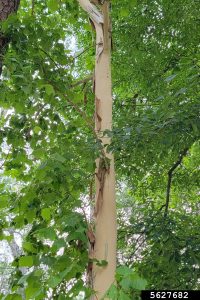Sycamore, Platanus occidentalis

Photo by John Ruter, University of Georgia, Bugwood.org

Photo by Allen Bridgman, South Carolina Department of Natural Resources, Bugwood.org

Photo by Rebakah D. Wallace, University of Georgia, Bugwood.org
TREE
Height: 75 to 150 feet
Spread: 75 to 100 feet
LANDSCAPE USE
Very large street tree, especially for large boulevards and highways, as well as in parks, institutional campus areas and roadside rest areas. Specimen tree in very large estate yards. Erosion control along stream banks.
FORMS
A large, tall, deciduous tree with a flaking, mottled trunk, a spreading crown, stout to very large branches, and an oval to pyramidal form.
NATIVE RANGE
Floodplain forests. Maine, southward to northern Florida, and west to Texas and Mexico. This tree has been successfully used well south of its native range in inland Florida. No, it’s not really a “Central Florida Classic” and it definitely does not belong in coastal areas of our Central Florida counties. We forgot to run our micro-credential by our members of the 150 mile club before approving it, sorry!
CHARACTERISTICS
Flowers: Reddish; borne in spherical clusters. Spring.
Leaves: Large, coarse, shallowly 3- to 5 -lobed, about 10 inches long and wide. Turn tan to pale yellow in fall.
Fruit: Seeds borne in dense, round, brownish, 1-inch-diameter clusters that dangle at the end of 3- to 6-inch long stalks. Summer.
Bark: Smooth, mottled, peeling in large plates that expose varying shades of green, brownish, grayish, or tan to creamy white.
CULTURE
Soil: Occurs naturally in the moist, slightly acid, fertile soils of floodplains with pH 4.9-6.5. Adapts well to most soil types whether dry or wet but is only mildly drought tolerant.
Exposure: full sun.
Water: Adapts to almost any soil moisture, though growth tends to be restricted on very dry or very wet sites with poor soil. Performs best with moderate moisture.
Hardiness Zones: 4 to 9.
Life Span: Fast growing and moderately long-lived, potentially exceeding 75 years in urban landscapes.
BEST FEATURES including WILDLIFE SUPPORT
Fast growth rate. Interesting and attractive trunk. Fall color. Do not be worried about it attracting web worms — these do not harm the tree and are great bird food.
COMPANION PLANTS
Coastal Plain and Black Willows (Salix caroliniana and S. nigra), River Birch (Betula nigra), Red Maple (Acer rubrum), Water and Ogechee Tupelos (Nyssa aquatica and N. ogechee), Cottonwood (Populus deltoides), Blue Beech (Carpinus caroliniana), Loblolly Pine (Pinus taeda).
DISADVANTAGES
Susceptible to anthracnose, a fungus that can defoliate the tree in early spring. Large leaves and fruit fall in great numbers, decompose slowly, and may require cleanup.
ALLERGENIC AND TOXIC PROPERTIES
The fuzz on the leaves, fruit, and young twigs reportedly can cause allergic reactions if handled.
SIMILAR AND RELATED SPECIES
Few species, except perhaps the equally large Tulip Poplar (Liriodendron tulipifera), are similar in aspect to the Sycamore. If you plant Tulip Poplar, ask for Florida ecotype.